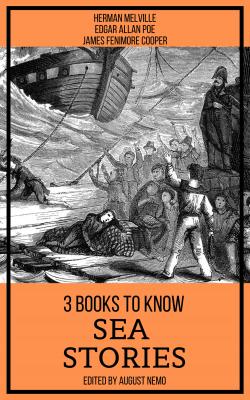3 books to know Sea Stories. Джеймс Фенимор Купер
Читать онлайн.| Название | 3 books to know Sea Stories |
|---|---|
| Автор произведения | Джеймс Фенимор Купер |
| Жанр | Языкознание |
| Серия | 3 books to know |
| Издательство | Языкознание |
| Год выпуска | 0 |
| isbn | 9783968589794 |
|
|
|
Introduction
Welcome to the 3 Books To Know series, our idea is to help readers learn about fascinating topics through three essential and relevant books.
These carefully selected works can be fiction, non-fiction, historical documents or even biographies.
We will always select for you three great works to instigate your mind, this time the topic is: Sea Stories.
Moby Dick by Herman Melville
The Pilot: A Tale of the Sea by James Fenimore Cooper
The Narrative of Arthur Gordon Pym of Nantucket by Edgar Allan Poe
Moby-Dick; or, The Whale is an 1851 novel by American writer Herman Melville. The book is sailor Ishmael's narrative of the obsessive quest of Ahab, captain of the whaling ship Pequod, for revenge on Moby Dick, the giant white sperm whale that on the ship's previous voyage bit off Ahab's leg at the knee. A contribution to the literature of the American Renaissance, the work's genre classifications range from late Romantic to early Symbolist. Moby-Dick was published to mixed reviews, was a commercial failure, and was out of print at the time of the author's death in 1891. Its reputation as a "Great American Novel" was established only in the 20th century, after the centennial of its author's birth. William Faulkner confessed he wished he had written the book himself, and D. H. Lawrence called it "one of the strangest and most wonderful books in the world" and "the greatest book of the sea ever written". Its opening sentence, "Call me Ishmael", is among world literature's most famous
The Pilot, in full The Pilot: A Tale of the Sea, novel by James Fenimore Cooper, published in two volumes in 1823. The work, which was admired by Herman Melville and Joseph Conrad for its authentic portrayal of a seafaring life and takes place during the American Revolution, launched a whole genre of maritime fiction. It features a mysterious and almost superhuman American sea pilot (based on the American hero John Paul Jones) who fights battles off the coast of England against the British and American loyalists. One of the book’s themes is the ambiguous nature of loyalty. Although often bogged down by complicated nautical terminology and intrusive philosophical dialogue, the novel is nevertheless noted for its spiritual and moral dimensions.
The Narrative of Arthur Gordon Pym of Nantucket (1838) is the only complete novel written by American writer Edgar Allan Poe. The work relates the tale of the young Arthur Gordon Pym, who stows away aboard a whaling ship called the Grampus. Various adventures and misadventures befall Pym, including shipwreck, mutiny, and cannibalism, before he is saved by the crew of the Jane Guy. Aboard this vessel, Pym and a sailor named Dirk Peters continue their adventures farther south. Docking on land, they encounter hostile black-skinned natives before escaping back to the ocean. The novel ends abruptly as Pym and Peters continue toward the South Pole.
The story starts out as a fairly conventional adventure at sea, but it becomes increasingly strange and hard to classify. Poe, who intended to present a realistic story, was inspired by several real-life accounts of sea voyages, and drew heavily from Jeremiah N. Reynolds and referenced the Hollow Earth theory. He also drew from his own experiences at sea. Analyses of the novel often focus on the potential autobiographical elements as well as its portrayal of race and the symbolism in the final lines of the work.
This is one of many books in the series 3 Books To Know. If you liked this book, look for the other titles in the series, we are sure you will like some of the topics
|
|
|
Authors
Herman Melville was born in New York City in 1819. He worked as a crew member on several vessels beginning in 1839, his experiences spawning his successful early novels Typee (1846) and Omoo (1847). Subsequent books, including his masterpiece Moby-Dick (1851), sold poorly, and by the 1860s Melville had turned to poetry. Following his death in New York City in 1891, he posthumously came to be regarded as one of the great American writers.
James Fenimore Cooper, (born September 15, 1789, Burlington, New Jersey, U.S.—died September 14, 1851, Cooperstown, New York), first major American novelist, author of the novels of frontier adventure known as the Leatherstocking Tales, featuring the wilderness scout called Natty Bumppo, or Hawkeye. They include The Pioneers (1823), The Last of the Mohicans (1826), The Prairie (1827), The Pathfinder (1840), and The Deerslayer (1841).
Edgar Allan Poe, (born January 19, 1809, Boston, Massachusetts, U.S.—died October 7, 1849, Baltimore, Maryland), American short-story writer, poet, critic, and editor who is famous for his cultivation of mystery and the macabre. His tale “The Murders in the Rue Morgue” (1841) initiated the modern detective story, and the atmosphere in his tales of horror is unrivaled in American fiction. His “The Raven” (1845) numbers among the best-known poems in the national literature.
|
|
|
